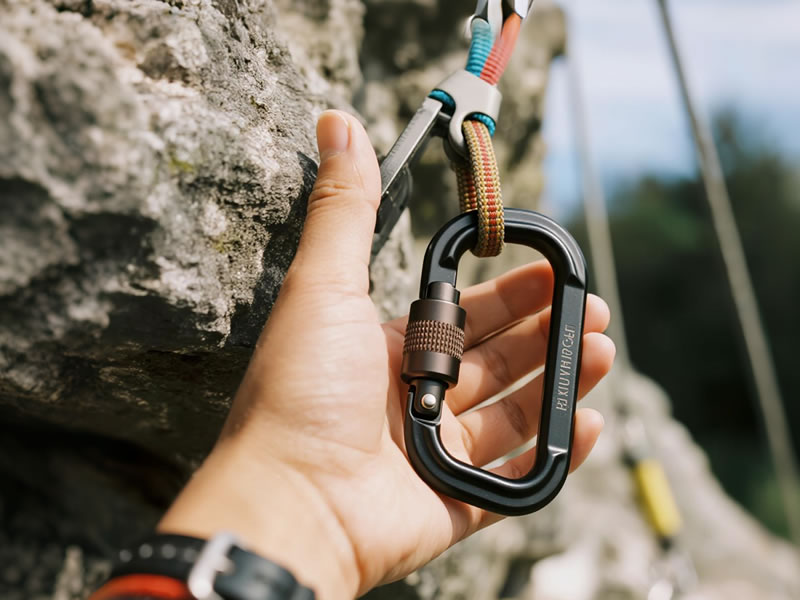Mini Climbing Carabiner Non-Load-Bearing: The Critical Line Between Convenience and Catastrophe
Using a mini climbing-style carabiner for anything beyond organization isn't just risky—it's potentially lethal. These downsized replicas of life-saving equipment leverage climbers' trust in their iconic form while hiding terrifying limitations. Here’s how to harness their organizational power without gambling with lives.

The Deadly Misconception
Mini carabiners mimic climbing gear aesthetics (keylock noses, anodized finishes) but share ZERO structural integrity with UIAA-certified counterparts. Deadly confusion arises when users assume:
- "It looks strong enough for a dog leash/gear sling"
- "The packaging shows mountain imagery"
- "It feels sturdy in hand"
Engineering Red Flags in Non-Load-Bearing Minis
| Component | Climbing-Grade | Non-Load-Bearing Mini | Failure Risk |
|---|---|---|---|
| Spine Material | 7075-T6 Aluminum | Cast 6061/Zamak alloy | Shatters under impact |
| Gate Pivot | Double-sleeved bushing | Single friction point | Binds when dirty/cold |
| Nose Design | Keylock/round nose | Sharp notched nose | Cuts webbing under tension |
| Testing | 100,000+ cycle fatigue test | 0–500 cycles (if tested) | Unpredictable fatigue failure |
Permitted vs. Prohibited Uses
✅ Safe Organizational Roles
- Rack Management: Hanging quickdraws on harness gear loops
- Camp Organization: Suspending cooking utensils from tent loops
- Training Aids: Demonstrating clipping techniques on ground
- Keychain Redundancy: Secondary attachment behind rated clip
❌ Lethal Misapplications
- Attaching dogs/children to fixed lines
- "Temporary" anchor extensions
- Supporting gear >0.5kg (1.1 lbs) dynamically
- Rappel backup devices
⚠️ Real Incident: A 2018 canyoneering fatality occurred when a "mini biner" holding a throw bag failed at 80 lbf—less than the weight of a 10-year-old child.
Manufacturer Responsibility Failures
Despite known risks, brands dangerously imply strength through:
- Climbing Terminology: "Carabiner," "gate," "spine"
- Visual Deception: Printed UIAA-like certification marks
- Ambiguous Marketing: "For outdoor use" without disclaimers
- Inadequate Warnings: Buried disclaimers in microscopic print
4-Point Safety Protocol
- VISUAL MARKERSPaint non-load-bearing biners fluorescent red or drill 3mm holes in spines.
- WEIGHT TAGSAttach permanent tags: "MAX 0.5kg / 1.1 lbs - NOT FOR LIFE SUPPORT"
- STORAGE ISOLATIONStore separately from climbing gear to prevent confusion.
- ANNUAL RETIREMENTReplace every 12 months regardless of condition (hidden fatigue).
Industry Leaders Setting Standards
| Brand | Safety Innovation | Visual ID System |
|---|---|---|
| Petzl | Laser-etched "NON-STRUCTURAL" warnings | Blue anodization + cross-hatch |
| Black Diamond | Gate-less designs for organization only | Flat profile with no gate |
| Edelrid | Integrated RFID safety chips | Scannable NFC warning tags |
When Organization Becomes Tragedy
Hospital Case Study: A nurse clipped a pulse oximeter to a patient’s gown using a "cute climbing carabiner." When the patient rolled over:
- Mini biner deformed at 1.5kg load
- Oximeter cable snapped
- Monitor failed during critical hypoxia
- Result: Delayed intervention → permanent brain damage
The Verdict: A Call for Industry Reform
Non-load-bearing mini carabiners require:
- Standardized Visual Warnings (ISO symbols)
- Mandatory Strength Testing (ASTM F3313 for micro hardware)
- Marketing Sanctions against climbing imagery
- Retailer Accountability for misuse education
Until reforms come:
- Treat every mini carabiner as DEADLY UNTIL PROVEN OTHERWISE
- Use only UIAA-certified biners for any load-bearing scenario
- Demand test certificates from mini biner manufacturers
Action Step: Audit your gear today. Destroy non-compliant minis with bolt cutters. Replace organizational needs with rated soft shackles or plastic clips that can't be mistaken for life-saving gear.






